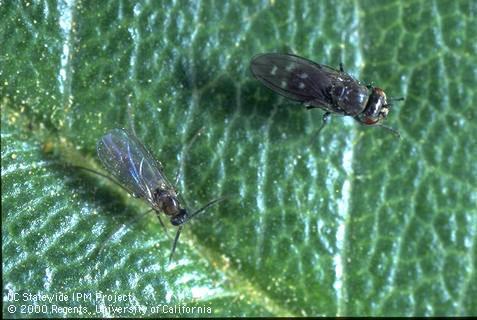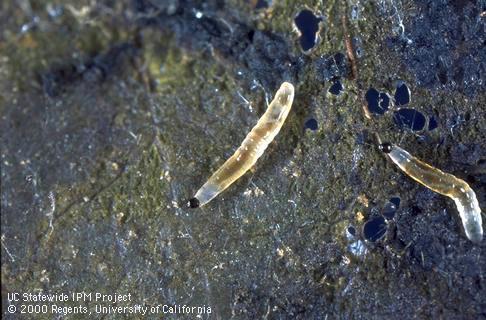Science to the Grower: Give your potting mix the gentle and clean smell of freshly laundered linens while it repels insect pests
by Richard Evans
Many of us think that fungus gnats are nothing more than a light snack. Consuming them while working in a greenhouse is as natural as breathing. It’s true that, in the greenhouse, the adult gnats don’t have much effect other than as a dietary supplement for workers. The young gnats, however, like youngsters everywhere, can be serious pests. The larvae feed on roots, and may spread plant pathogens like Fusarium oxysporum.
What to do about them? We have known for years that fungus gnats prefer wet conditions, so providing good drainage and avoiding overwatering are cultural practices that may keep their numbers low. The gnats also like rotting plant material, so mulches, partially composted organic matter, and even organic fertilizers can attract and harbor them. Therefore growers need to make judicious use of these materials if gnats are a potential problem, and store them in closed containers to exclude gnats.
Chemical and biological controls for fungus gnats are also available. Soil drenches with broad-spectrum insecticides are effective, but also can kill beneficial organisms or pollute surface waters. Research in the 1990s showed that nematodes and predatory mites can be effective biological control agents (Chambers and others, 1993; Harris and others, 1995). Even earlier, researchers reported that a microbial insecticide, Bacillus thuringiensis subspecies israelensis (Bti), is effective against fungus gnat larvae (Osborne and others, 1985). However, the predatory mites and the microbial insecticide are short-lived, so frequent applications are necessary. Also, Bti is effective only on larvae, not on later-stage insects, so its effectiveness depends on applications made before the fungus gnat populations boom (Cloyd and Dickinson, 2006).
Now scientists have discovered a new method of controlling fungus gnats. Well, maybe they didn’t discover it. For years, gardeners, athletes, hunters and other fans of outdoor activities have extolled the benefits of Bounce® fabric softener dryer sheets as a mosquito and gnat repellent. The claim was made that these sheets, folded and placed in a shirt pocket, would repel adult insects for many hours.
This wasn’t hard for me to believe, considering how repellent those sheets are to me, but more convincing evidence was recently reported by Cloyd and others (2011). These scientists tested the efficacy of the Outdoor Fresh Scent™ version of the fabric softener sheets in a laboratory experiment involving adult fungus gnats and a commercial potting mix in containers that either had a small piece of the dryer sheets on it or was left uncovered. They found that a much lower percentage (12 to 18%) of the gnats were present in the dryer sheet treatments than in the uncovered controls (33 to 48%). Voilà!
Even better, Cloyd’s group analyzed the volatile compounds released by the dryer sheets. Prominent ones included linalool, which is toxic to many mites and insects but hadn’t been reported as a repellent, and citronellol, which was already known to be a mosquito repellent. It remains to be seen how long the dryer sheets are repellent, and at what range they are effective, and how well they work in a greenhouse filled with plants and dryer sheets. I wonder if Procter and Gamble will offer financial support.

Adult fungus gnat (left) and shore fly, (right) from UC Davis greenhouses on leaf (5x). Source: UC IPM. (Photo by Jack Kelly Clark)

Fungus gnat larvae on underside of fallen leaf on container plant media surface (3x) in UC Davis greenhouse. Source: UC IPM. (Photo by Jack Kelly Clark)
References
Chambers RJ, Wright EM, Lind R.J. 1993. Biological control of glasshouse sciarid flies (Bradysia spp.) with the predatory mite, Hypoaspis miles, on cyclamen and poinsettia. Biocontrol Science and Technology 3:285–293.
Cloyd RA, Dickinson A. 2006. Effect of Bacillus thuringiensis subsp. israelensis and neonicotinoid insecticides on the fungus gnat Bradysia sp nr. coprophila (Lintner) (Diptera: Sciaridae). Pest Management Science 62:171-177.
Cloyd RA, Marley KA, Larson RA, Arieli B. 2011. Bounce® fabric softener dryer sheets repel fungus gnat, Bradysia sp. nr. coprophila (Diptera: Sciaridae), Adults. HortScience 45:1830-1833.
Harris MA, Oetting RD, Gardner WA. 1995. Use of entomopathogenic nematodes and a new monitoring technique for control of fungus gnats, Bradysia coprophila (Dipt.: Sciaridae), in floriculture. Biological Control 5:412–418.
Osborne LS, Boucias DG, Lindquist RK. 1985. Activity of Bacillus thuringiensis var. israelensis on Bradysia coprophila (Diptera: Sciaridae). Journal of Economic Entomology 78:922–925.
Richard Evans is UC Cooperative Extension Specialist for Nursery Crop Production, Department of Plant Sciences, UC Davis.












